One thing I always hear is that it's difficult to do a long distance trip in an EV. Of course in a way its different to doing a long distance trip in an ICE vehicle, but generally its not too hard in a modern EV that has DC rapid charging.
I recently had the chance to choose between using a diesel Insignia or an EV for a trip up to the Lake District. Naturally I chose the EV. I prefer the ease of driving an EV compared to a manual ICE with all the gear changes.
Planning
Everyone says you need to do a bit of planning when using an EV for long trips. For me with a modern large capacity EV its not as necessary as it once was. Modern EV's often have built in navigation systems that will alo recommend when and where to charge. There are various apps for your phone that can plan your trip which will include a suggested charge stop. I quite like the 'A Better Road Planner (ABRP) app to do this.
Route there
Route back
To be honest I often now don't look at look at these planning apps. We often visit the Lake District and take roughly the same route therefore I know there are plenty of charging locations along the A1.
If we're going somewhere we haven't been before I may look up the location of my favourite charger providers (Tesla, GridServe, Instavolt) just to see if there are any locations on my route, or put the journey into the ABRP app just to see what they recommend.
The actual journey
Planning is one thing but the doing the journey is another. I roughly followed the above routes on the way there and back. We charged at the Tesla Superchargers at Weetons Harrogate on the way there. I like that stop as there are good toilets and the garden centre has a dog friendly cafe too (dog's aren't allowed in the farm shop or the main restaurant).
My parents were shocked that the EV car was ready to go again after 25 minutes (they were expecting it to take much longer from what they had read in the media). We lost them as they had gone in to the garden centre and into the main restaurant. They were gone for over an hour as they had ordered a scone that took a long time as the restaurant was busy.
On the way home we made a short stop at Weetons in Harrogate but we didn't charge as we still had 64% left.
We did stop at the Welcome Break Newark Services to use the Applegreen 180kW DC rapid chargers. The Starbucks and Welcome Break Services cafe (Pret, Greggs & Burger King) allow well behaved dogs into the seated areas.
The other good thing about the Applegreen chargers at Newark is that they are paired with Electroverse so we get a slight discount. The charge was a quick 'splash and dash' as it was 71p/kWh on Electroverse. I don't see much point charging back up to 80% when we don't need that much to get home. Why fully charge at 71p/kWh when we know we have our own home charger (7p/kWh) at home? I decided to only recharge to 50% as that should give us enough to get home with 15-20% battery left. The ABRP app actually suggestted a higher recharge to 65% but we had arrived with more battery left than it suggests we would therefore I thought we could get away with charging less. Knowing there are other charger locations on route if I had calculated it wrong just means we may need to make another quick stop if the battery gets a bit too low.
Cost of a long trip
Whenever you mention a long trip in an EV to anyone they think the whole trip will be charged from the most expensive rapid chargers making it more expensive than doing the same trip in a petrol or diesel vehicle.
Over the week we travelled from home to Eskdale in the south west of the Lake District. We then travelled from Eskdale around to Ambleside via Keswick. We travelled to various locations local to Ambleside, before travelling home from Ambleside. We travelled a total of 738.2 miles.
We charged using only public chargers. Whilst we had an EV charger at our accommodation we couldn't get it to work as there was a communication issue between the Rolec charger and the Monta app the accommodation's owner was using to take payment for EV charging. This wasn't an issue as there were 'Charge my Street' 22kW chargers in a local car park.
We used a combination of rapid DC chargers, destination chargers and of course home charging. We used a total of 223.19kWh's costing £93.16.
Screenshots of the EV charging receipts just to prove its not made up data!

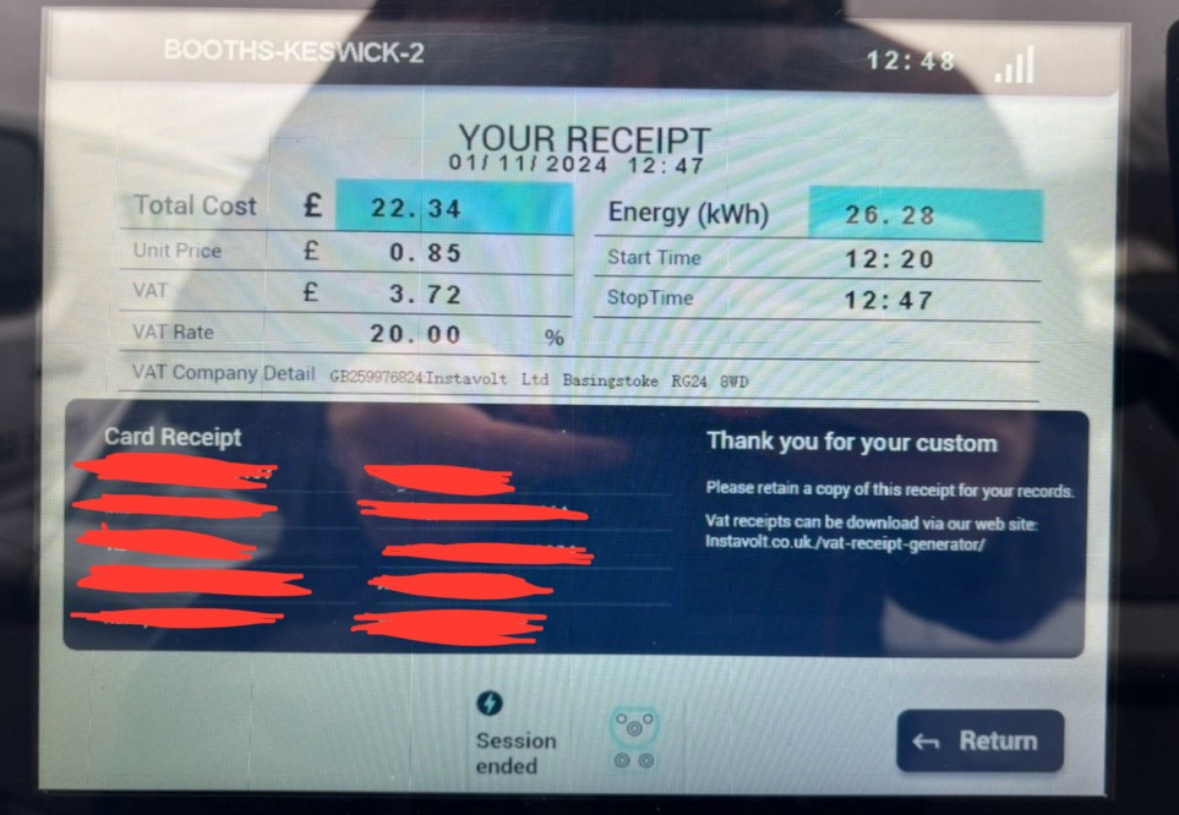
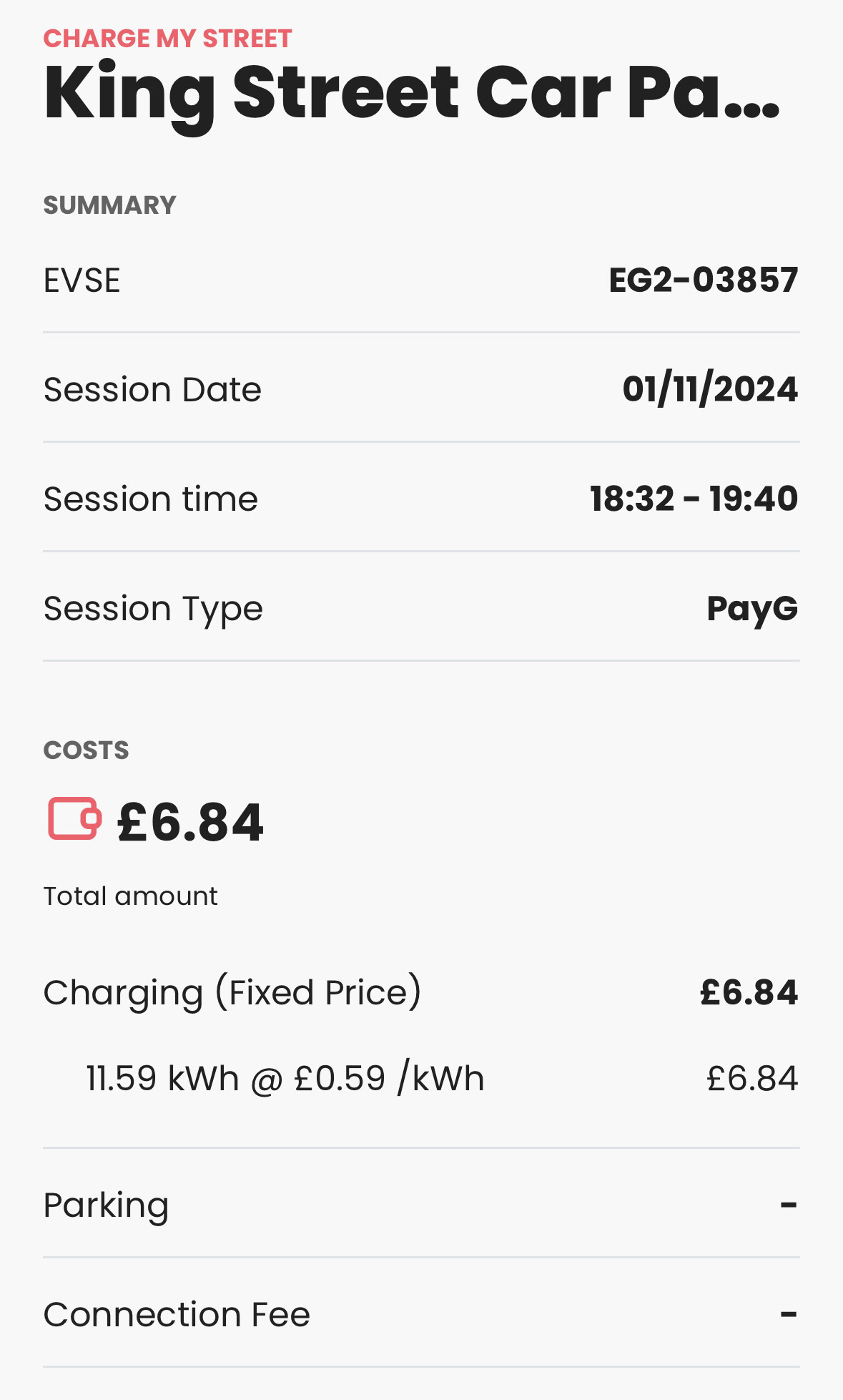
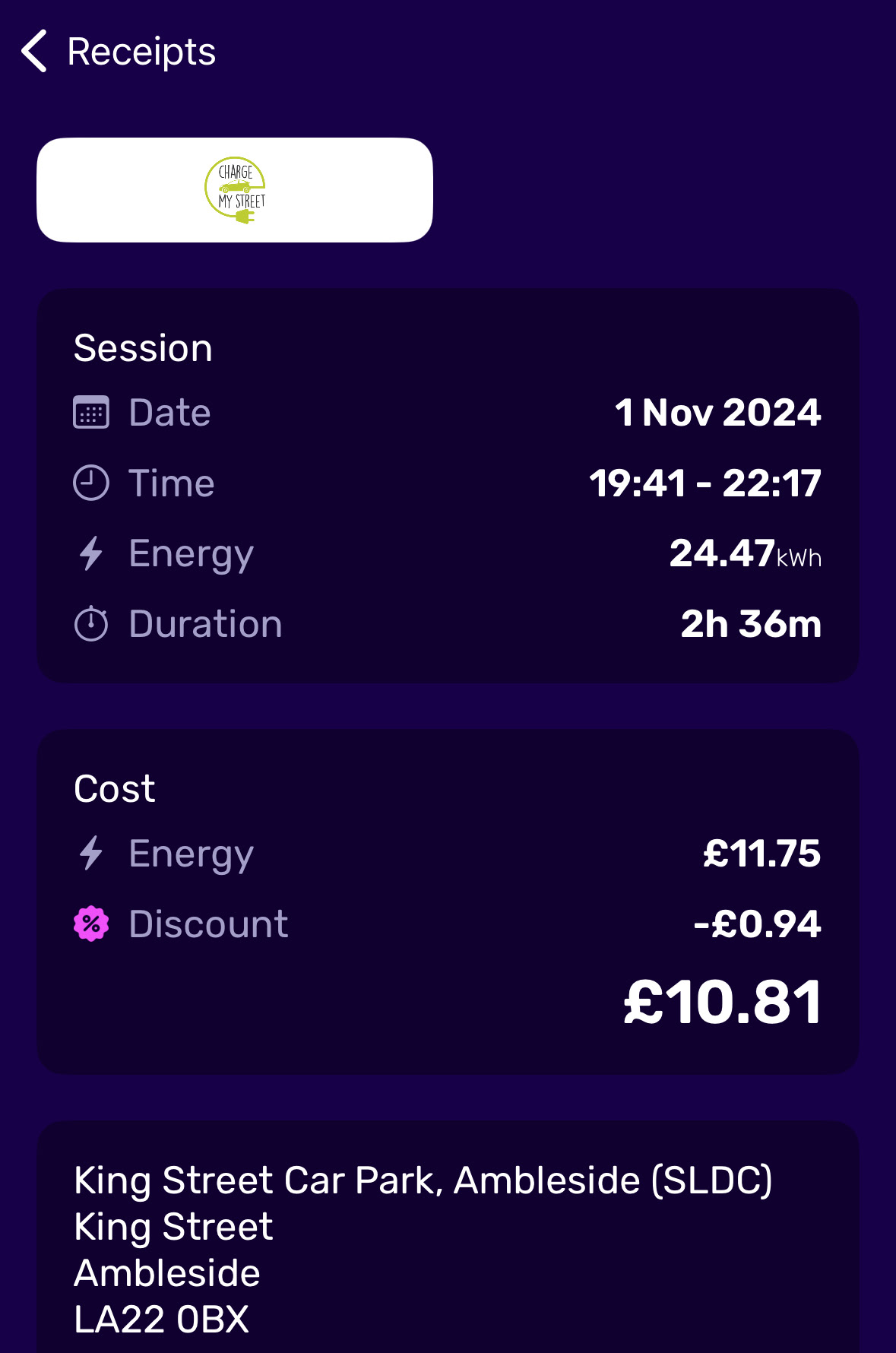
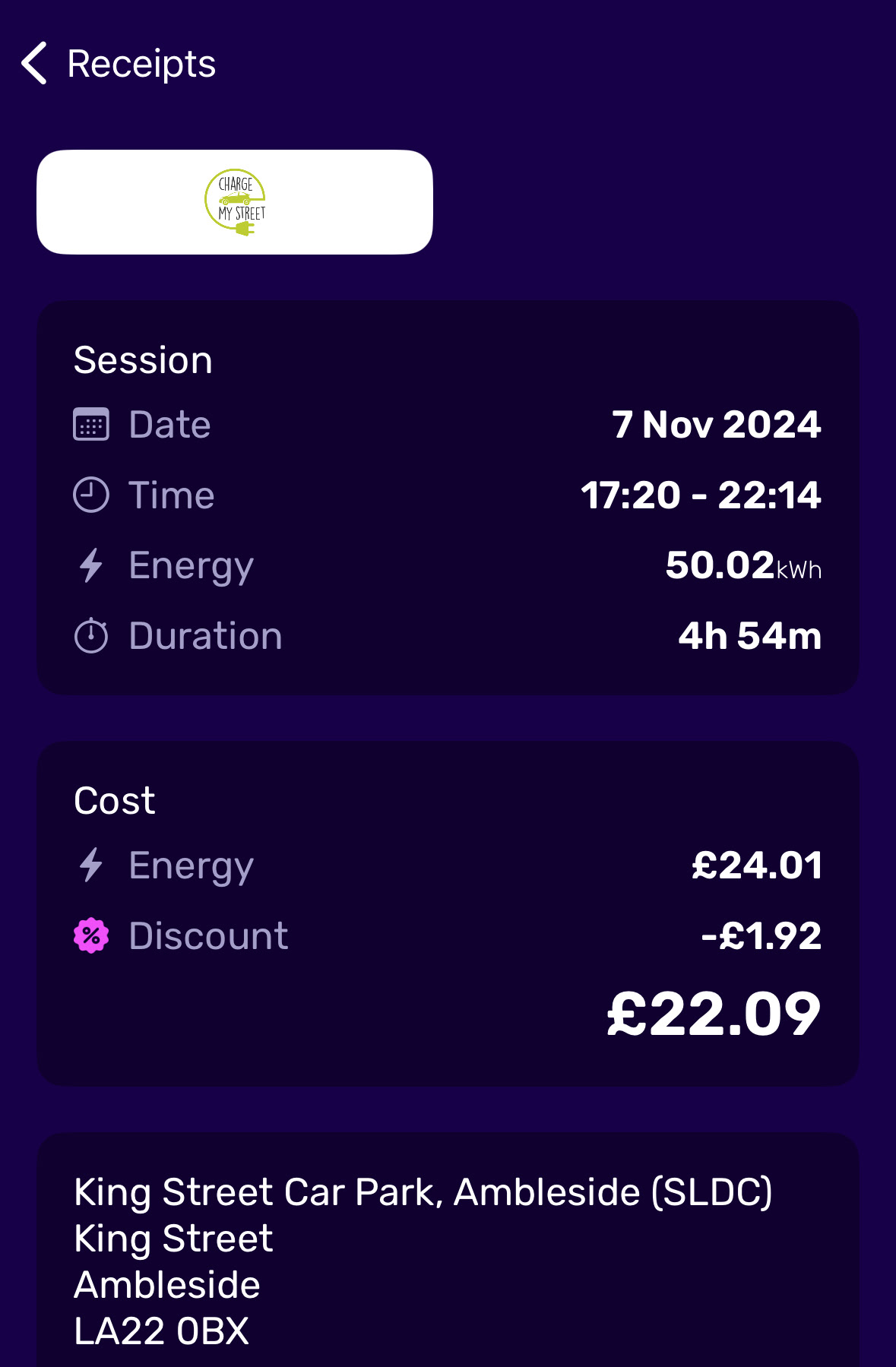
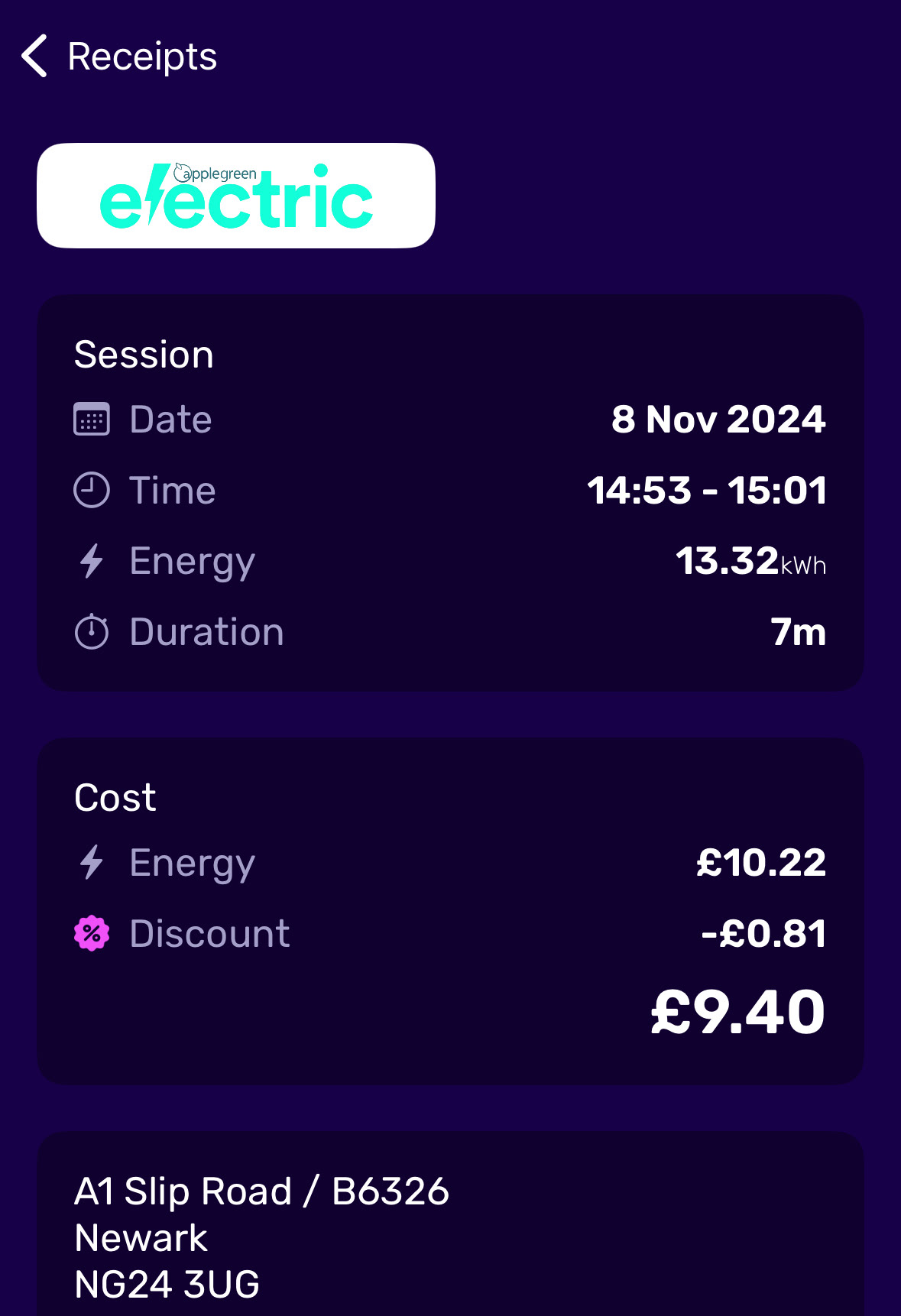
When you look at the individual cost of charging at the different locations you can see there is a big different in the cost per mile. At the highest cost per kWh (InstaVolt chargers at Keswick) it was 85p/kWh so that 25.7p per mile. If you compare that to the Tesla SuperChargers at Harrogate 48p/kWh which is 14.5p per mile.
Just like in a petrol car you wouldn't refill only at the most expensive motorway locations. You'd refill just enough to get you to a cheaper location later on. At that point you're paying more for the convenience of not going too far off route.
The cost of different charging types
When we look at the different types of charging used its interesting to see the differences between them. What I wasn't expecting was there isn't much difference in between actual kWh's used from the different types of charging.
Destination charging was the most used type of charging, followed by rapid charging. If we weren't initially going over to the south west area of the Lake District which is well known for its lack of EV charging infrastructure we may have charged less at Harrogate Tesla as it is only 80 miles from there to Ambleside. That said there wasn't a huge difference in in the kWh unit cost at Harrogate Tesla (48p/kWh) compared to Charge My Street using the Electroverse app (44p/kWh) in Ambleside so it doesn't make as much difference to cost compared to using higher cost rapid chargers like Instavolt at Kewsick (85p/kWh). In hindsight we could have potentially used the Charge My Street destination chargers at Keswick. At 11kW charger rate would could have charged the same amount in 2.5 hours as we did in 27 minutes using the Instavolt rapid charger (we stayed for 3 hours in Keswick too so plenty of time to charge).
Home charging to fill the EV's battery up is of course much cheaper than both rapid or public destination charging. How far you can go on your home charging really depends on the range of your EV. Our EX30 has a real world range of around 225 miles so thats a big chunk of the trips overall mileage covered at 7p/kWh.
Using the total mileage, kWh's transferred during charging and the total cost we can work out the efficiency and the cost per mile.
The efficiency at 3.31 mile per kWh was lower than the EV's reported 27.5 miles per 100 miles (ie 3.64 miles per kWh). This is partly because the EV's efficiency calculation doesn't include power lost from transfer losses during charging whereas my calculations do.
I'm quite impressed that the cost per mile was just 12.6p. When compared to petrol it was the equivalent to 47 MPG and 49 MPG for a diesel.
I'd say it would be a little cheaper per mile using petrol or diesel on this particular trip, but that doesn't take into account the cost over the whole year. Our EV is generally charged at home for 2.1p per mile (7p/kWh on Intelligent Octopus Go with 3.3 miles per kWh efficient from the trip equals 2.1p per mile) so the cost over the year would be much lower even when taking the odd long distance trip each year. Annual charging costs really depends how much you can charge from home. A few long trips away from home ac year aren't going to increase the cost hugely over the year.
Summary
Long trips in an EV aren't as difficult as they once were for long trips as modern EV's have longer ranges and faster DC rapid charging. The cost is likely lower than people think because you will likely use a variety of charging types rather than just expensive motorway rapid chargers.
Did we have any charging issues?
Whilst charging was generally easy and trouble free we did have one issue at a EV Point rapid charger near Whitehaven. I couldn't get either Electroverse or contactless to work. I couldn't use the EV Point app because the EV charger wasn't even listed!
We moved onto the InstaVolt chargers at Keswick where the electroverse app again didn't work but contactless payment did. I think some of the electroverse app issues were due to poor mobile data signals in the Lake District. It didn't help that we didn't have the Electroverse RFID card with us as a backup to the app.
I later found out I could have also used the 'Charge my Street' in Skiddaw Street Car park. At 44p/kWh it would have been nearly half the cost of the InstaVolt rapid chargers. We would have also charge the same amount of kWh's in the 3 hours we were in Keswick for too.
Tips
* Try to start your long trip with a full battery charged up to 100% just before you leave home.
* Look out for cheaper destination charging options if you are going to be staying for a few hours in one place.
* Use the cheapest rapid changers where possible (Tesla have a few locations open to all EV's).
* Look out for discounts on app's like Electroverse. Using the fuuse app for Charge my street chargers was 59p/kWh but only 44p/kWh on Electroverse.
* The quickest chargers are destination chargers as you're doing something else whilst the EV is charging (the same can be said for rapid chargers if you're going to the toilet or taking a break).